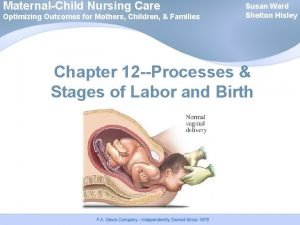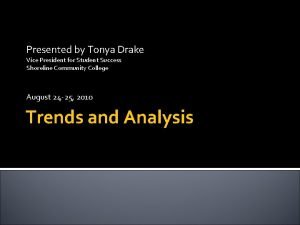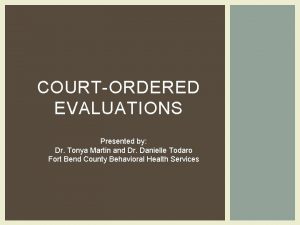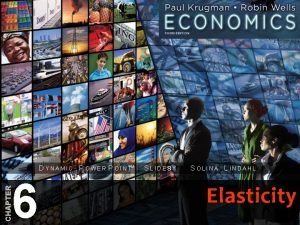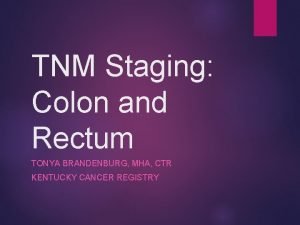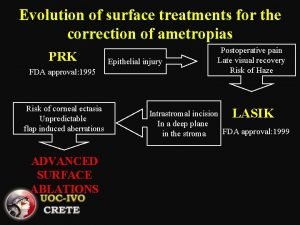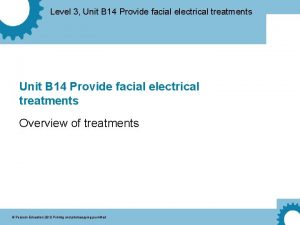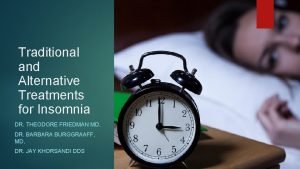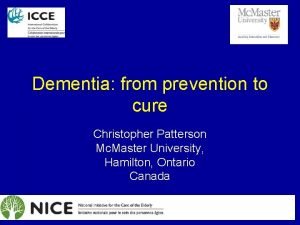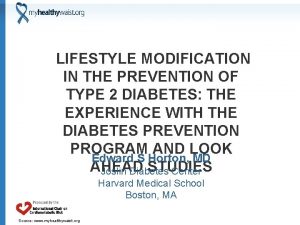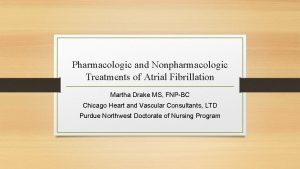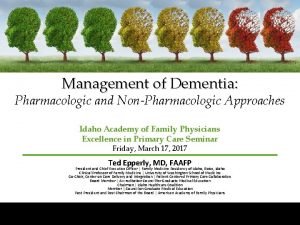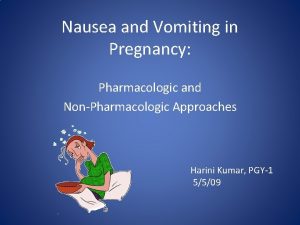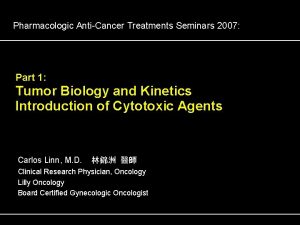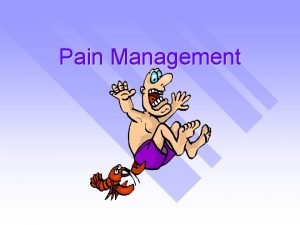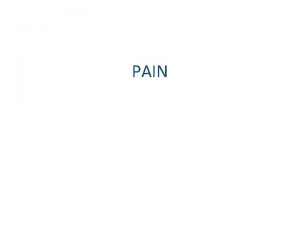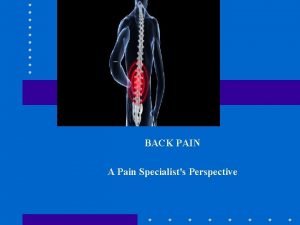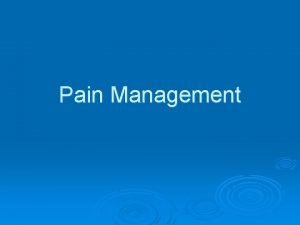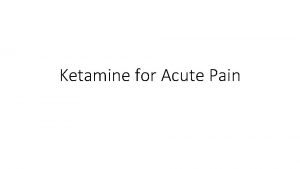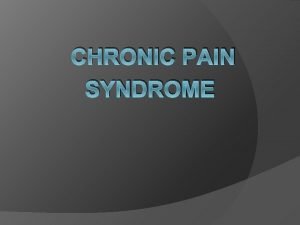Pharmacologic vs Nonpharmacologic Treatments of Pain Tonya Allendorfer


















- Slides: 18

Pharmacologic vs. Nonpharmacologic Treatments of Pain Tonya Allendorfer Ashley Borowiak Tara Braun Danielle Bular Niccole Colthorp

Purpose Statement ● This powerpoint will discuss the different aspects of pain management and treatment options. Pharmacological vs. Nonpharmacological ○ Relevancy of treatment and reassessment ○ Analysis of evidence ○

What is Pain? “Pain is an uncomfortable feeling that tells you something may be wrong. It can be steady, throbbing, stabbing, aching, pinching, or described in many other ways. Sometimes, it’s just a nuisance, like a mild headache. Other times it can be debilitating” (John Hopkins Medicine, 2013). Every patient will experience pain in a different way. The pain is a subjective feeling and it is whatever the patient says it is.

Acute vs. Chronic Pain “Pain is classified as either acute or chronic. Acute pain is usually severe and short-lived, and is often a signal that your body has been injured. Chronic pain can range from mild to severe, is present for long periods of time, and is often the result of a disease that may require ongoing treatment” (John Hopkins Medicine, 2013). Because people experience pain differently a person with acute pain will react differently than a person dealing with chronic pain. Someone who is on pain medications for long periods of time can build a tolerance requiring more or different treatment to control the chronic pain. This does not necessarily mean they are addicted.

Pharmacological Treatment: Opioids Purpose of opioid use (often referred to as narcotics) in advanced stage of disease: To minimize the amount of pain and discomfort an individual may feel at the end of life (National Institute for Health and Care Excellence, 2012).

Types of Opioids Codeine Hydromorphone Levorphanol Methadone Morphine Oxycodone Hydrocodone Oxymorphone Fentanyl (American Cancer Society, 2013)

Why are opioids administered? • • • Opioids are given to patients with advanced disease to provide pain relief and to ease the feelings associated with shortness of breath. Opioids are a preferred choice in treating pain with advanced disease because they can be given many different routes to accommodate the patient’s changing condition. Opioids can be given orally (tablet and liquid forms), intramuscular, sublingual and buccal, intravenous, transdermal, rectally and subcutaneous. (National Institute on Aging, 2013).

Common Myths About Opioids • • Myth: Opioids are addicting Fact: Addiction is rare for individuals in a state of advanced disease because their body is requiring pain relief and they have most likely built some sort of tolerance. Myth: Opioids cause respiratory depression Fact: Respiratory depression is rare if opioids are given correctly and doses adjusted slowly. Myth: Administering opioids to a terminally ill patient will bring on death quicker. Fact: Research has proven that the use of opioids at the end of life does not bring death on any quicker, and to withhold medication for this reason could cause an increase in patient suffering. Myth: People who use opioids are weak and/or bad individuals. Fact: The media has tarnished the image of those who use opioids for pain relief. In turn, unfortunately, this has caused many individuals to refuse opioid treatments which increases pain and suffering. (Hospice and Palliative Nurses Association [HPNA], 2009)

Nonpharmacological Treatments Skin Stimulation is a recommended nonpharmacological treatment. It proves to be promising in reducing pain and anxiety. Most appropriately used as an adjunct to opioids providing short term pain relief. (Bardia, Barton, Bauer, Moynihan, & Prokop, 2006)

• • • Skin Stimulation Massage-light or deep tissue Vibrations-good for low back pain Pressure-releases trigger points Heat or Cold-relieves sore muscles Menthol Ointments-increases circulation TENS units-mild electric impulses confuse pain signals (American Cancer Society, 2013)

Evidence of Pharmacological Treatments “In carefully selected and monitored patients, opioids may provide effective pain relief as part of a comprehensive pain management strategy” (Abdulla et al. , 2013) “Randomized control trials have demonstrated short-term efficacy in persistent musculoskeletal pain, including osteoarthritis and low back pain, and various neuropathic pains, such as post-herpetic neuralgia and diabetic peripheral neuropathy” (Abdulla et al. , 2013)

Evidence of Nonpharmacological Treatments The American Geriatric Society recommends the use of TENS units and states that is can be an effective approach (Abdulla et al. , 2013). Two of four alternative randomized controlled trials evaluating alternative medicine therapies for cancer-related pain reported “statistically significant reductions in pain measures immediately after massage” (Abdulla et al. , 2013).

Evidence of Nonpharmacological Treatments Continued Ten minutes of slow stroke back massage has been shown to reduce shoulder pain, which continued for 3 days after the massage, in older adults with a stroke. A form of massage known as ‘Tender Touch’ (gentle massage) does improve pain among older adults with chronic pain living in a long-term care facility. This approach has been said to improve communication among staff and the residents. (Abdulla et al. , 2013)

Analysis of Evidence and Recommendation Opioids should be used in managing symptoms associated with advanced disease. ● Opioids should be administered in advanced disease because not only have many of the myths been proven incorrect by research, but studies have shown that the relief and decreased suffering that a patient experiences outweighs withholding pain medications due possible side effects. The HPNA (2009) discuss many myths regarding opioid use and recommend this palliative treatment in their programs. • The evidence suggested by the HPNA and the American Cancer Society encourage use of opioid use in a safe manner to control symptoms in advanced disease. Both organizations provided strong evidence, as previously stated, along with referencing numerous studies on medications for symptom management.

Analysis of Evidence and Recommendation The various forms of skin stimulation should be used in managing symptoms of advanced disease. • • • Credible sources such as the American Geriatric Society and the American Cancer Society both provide supportive evidence along with numerous successful studies as to why numerous methods of skin stimulation should be used in advanced disease. The studies that were conducted using massage were done in a consistent manner, and evidence was strong that even massage for a short period of time has proven to be effective in pain management. The studies were reputable and credible. None of the studies research proved the various forms of skin stimulation to have a negative effect on people suffering from the symptoms of advanced disease, therefore, this has been

Conclusion Each person is unique and experiences pain in their own way. A holistic approach is best in developing a plan of care using both opioids and non pharmacological techniques, such as skin stimulation to reduce the suffering of those with advanced disease.

References Abdulla, A. , Adams, N. , Bone, M. , Elliott, A. M. , Gaffin, J. , Jones, D. , . . . Schofield, P. (2013) Guidance on the management of pain in older people. Age and Aging, 42(1), 1 -57. doi: 10. 1093/ageing/afs 200. American Cancer Society (2013). Opioid pain medications. Retrieved from http: //www. cancer. org/treatmentsandsideeffects/physicalsideeffects/paindiary/pain-control-opioid-pain-medicines American Cancer Society (2013). Skin stimulation. Retrieved from http: //cancer. org/treatmentsandsideeffects/physicalsideeffects/paindairy/pain-control-skin-stimulation Bardia, A. , Barton, D. , Bauer, B. , Moynihan, T. , & Prokop, D. (2006). Efficacy of complementary and alternative medicine therapies in relieving cancer pain: a systematic review. Journal of Clinical Oncology, 24(34), 5457 -64.

References continued National Institute on Aging (2013). Providing comfort at the end of life. Retrieved from http: //www. nia. nih. gov/health/publication/end-life-helping-comfort-and-care/providing-comfort-end-life National Institute for Health and Clinical Excellence (2012). Opioids in palliative care: safe and effective prescribing of strong opioids for pain in palliative care of adults. Retrieved from http: //publications. nice. org. uk/opioids-in-palliative-care-safe-andeffective-prescribing-of-strong-opioids-for-pain-in-palliative-cg 140 National Institute on Aging (2013). Providing comfort at the end of life. Retrieved from http: //www. nia. nih. gov/health/publication/end-life-helping-comfort-and-care/providing-comfort-end-life
 Fetal descent stations
Fetal descent stations 7 rights of medication administration in order
7 rights of medication administration in order Tonya drake
Tonya drake Ap stats practice test multiple choice
Ap stats practice test multiple choice Tonya orourke
Tonya orourke Tonya eval
Tonya eval Tonya consumes 10 boxes of ramen
Tonya consumes 10 boxes of ramen Tonya mha
Tonya mha Mad pain
Mad pain Period cramps vs early pregnancy cramps
Period cramps vs early pregnancy cramps Pms vs pregnancy symptoms
Pms vs pregnancy symptoms Advanced surface treatments
Advanced surface treatments Level 3 electrical facial
Level 3 electrical facial Insomnia treatment
Insomnia treatment Alternating treatments design
Alternating treatments design Dementia treatments and interventions near patterson
Dementia treatments and interventions near patterson Diabetes treatments
Diabetes treatments Hiv treatments
Hiv treatments Urinalysis
Urinalysis
